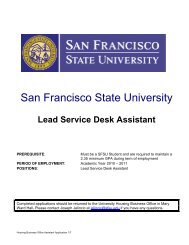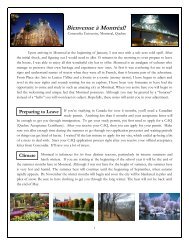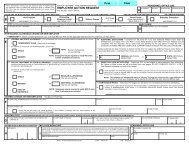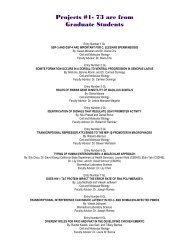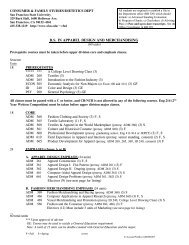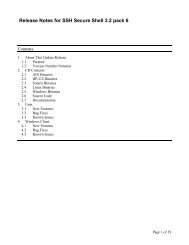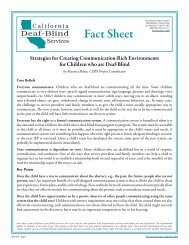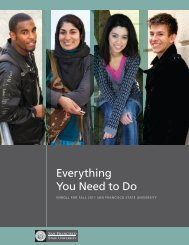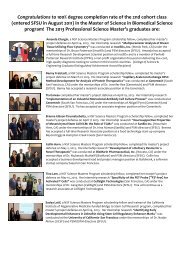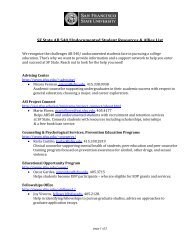reSources Spring 2008 (Vol. 13, No. 2) - San Francisco State ...
reSources Spring 2008 (Vol. 13, No. 2) - San Francisco State ...
reSources Spring 2008 (Vol. 13, No. 2) - San Francisco State ...
Create successful ePaper yourself
Turn your PDF publications into a flip-book with our unique Google optimized e-Paper software.
http://www.sfsu.edu/~cadbs/News.html<br />
California<br />
Deaf-Blind<br />
Services<br />
Sharing Information to Improve Your Children’s<br />
Learning Experiences at School: Strategies for<br />
Families from the Perspective of a Teacher<br />
By Gloria Rodriguez-Gil, CDBS Educational Specialist<br />
There are many important reasons for families to share<br />
basic information about their children with classroom<br />
staff and other service providers in school. These<br />
include to help children function at their best in order to<br />
facilitate learning, to lessen the time it takes service providers<br />
to get to know their students so they can get started working on<br />
educational goals, and to facilitate collaborative relationships<br />
with service providers from the very beginning.<br />
To begin with, let me share a recent story from my travels<br />
around California. Three weeks into this school year I visited a<br />
preschool classroom to observe a student I will call Sophie. The<br />
day began with the students eating breakfast with the support<br />
of the teaching staff. One of the breakfast choices on this day<br />
was bagel with cream cheese, and a classroom assistant cut the<br />
bagel into small pieces for Sophie. The assistant picked up a<br />
piece of bagel with a fork and offered it to Sophie by placing it<br />
in front of Sophie’s face at a close enough distance for her to<br />
see it (Sophie has vision loss). Sophie responded by refusing<br />
to open her mouth. I asked the classroom assistant if Sophie<br />
liked bagels and she responded by saying that she didn’t know<br />
what Sophie liked to eat. The classroom teacher explained to<br />
me later that Sophie had been in school for only three weeks.<br />
As the classroom assistant cut the bagel into pieces, I remember<br />
wondering if this particular student could really eat something<br />
like a bagel even if it was cut into small pieces. Sophie had<br />
significant motor challenges and walked with the aid of a<br />
walker. In addition, she was hard of hearing and communicated<br />
mainly through behaviors and actions (although she was able<br />
to imitate a few words when she was highly motivated, as she<br />
demonstrated later during the observation.) Since she didn’t<br />
communicate orally, I realized that some of her eating skills—<br />
particularly chewing—might be impacted by the development<br />
of oral-motor skills. The possibility that Sophie could chew<br />
and swallow something as hard as a piece bagel seemed low.<br />
In the end, the breakfast activity was not a very positive and<br />
constructive experience for Sophie.<br />
Sophie’s breakfast experience might have been more positive if<br />
Sophie’s family and school staff had communicated beforehand<br />
about Sophie’s feeding preferences, habits, and needs. With<br />
better information sharing, Sophie might not have been viewed<br />
as an uncooperative child or a child who could not understand<br />
and respond appropriately. Although this situation is specific<br />
to Sophie and her program, it is an example of something that<br />
is much more common, and happens to students when basic<br />
information has not been communicated clearly and timely.<br />
Professionals and paraprofessionals working with your<br />
child—especially when your child is new to a program—may<br />
not understand your child’s basic needs and other important<br />
information because their information is based only on brief<br />
observations in the classroom. The knowledge you have of<br />
your child is based on so much personal experience that it may<br />
be obvious to you, but may not come as naturally to service<br />
providers in the school. There may be written reports about<br />
your child but these reports do not provide a complete day-today<br />
“picture” of who your child really is. And not all service<br />
providers have easy access to these reports. Unfortunately,<br />
having provided information about your child once doesn’t<br />
mean that you may not have to provide it many more times.<br />
This will be particularly true every time the child goes into<br />
a new program and/or starts working with new people. And<br />
some information may have to be repeated several times to<br />
the same people for them to fully understand it in the way<br />
intended.<br />
In many cases, it is difficult for children who have vision and<br />
hearing loss and additional multiple disabilities to tell others<br />
about themselves. It is usually the responsibility of family<br />
members and/or the other adults who live with and care for<br />
these students to share this information so that educational<br />
teams can propose and design instructional activities based on<br />
the strengths and needs of the students. You can insure this<br />
information is shared by considering a few simple strategies.<br />
These strategies might be most applicable to a student who is<br />
new to a program.<br />
Who is the Child?<br />
You want to start by giving a positive view of your child (e.g.,<br />
who she is as a person, her personality, things she’s good at, and<br />
the things she likes and doesn’t like to do). This information<br />
(continued on page 6)<br />
California Deaf–Blind Services <strong>reSources</strong> Winter 2009 <strong>Vol</strong>. 14, Number 1 page 5



